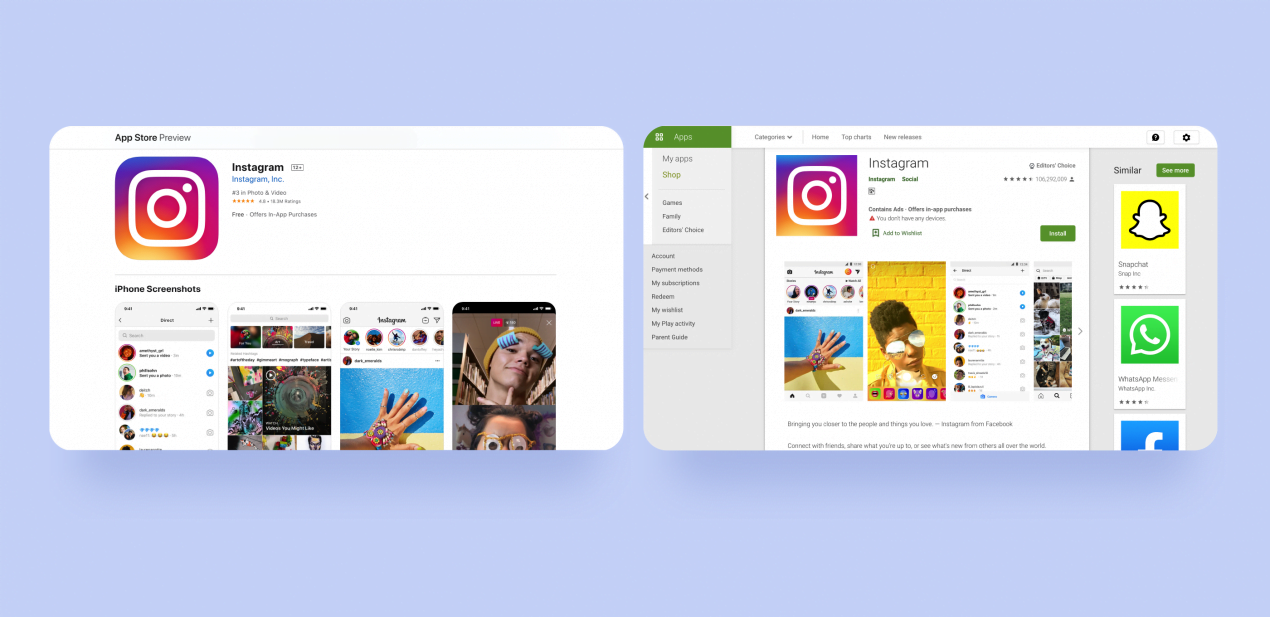The need for code sharing and cooperation marked the end of life for disclosed incompatible apps and platforms. Now the tech world strives to the maximum integrity and inclusiveness as only with these two a boost to functionality and productivity is guaranteed.
React Native is a two-birds-with-one-stone killer. The pioneer of hybrid mobile app development. Being the most famed cross-platform app developing framework it doesn’t seem to slow the roll — indeed, there are more and more professional React Native development agencies that use it!
What Is Cross-Platform Anyway?
Before the saving arrival of React Native, devs had to burn the midnight oil, creating at least two native variations of the same app for Android and iOS. But the game has changed and UIs breathed a sigh of relief. This cross-platform app developer enables us to write code once and use it for several platforms and software environments without the need to change 65-70% of it and getting the desired native-like quality. So-called “Write Once, Run Anywhere” (WORA) approach. It saves time, money, and effort spent on cross-platform development. Sounds amazing, works the same — it’s about React Native.
Why React Native?
Winning the hearts of UI/UX designers is hard, but keeping them is much harder. It’s not that there are no cross-platform app alternatives, let’s take one of the React Native competitors: Flutter for instance. Clearly, React Native has something to hook the users for long. Let’s see what it is.
Give-And-Receive Concept
One of the most prominent perks of using React Native for cross-platform development is codesharing. It has made a revolution in the app developing world, allowing to reduce the amount of work required for an application making. Code reusability simply means that you can write code once and then apply it for any platform, making from 10 to 40% of minor changes. The feature makes it possible for big teams to cooperate regardless of the software ecosystem they’re in. What if enclosed private apps for each platform would have been more efficient? React Native has convinced us otherwise.
Speak The Common Language
Among the variety of coding languages, JavaScript is an undeniable leader, an absolute must for any dev. Winning the majority in the tech world, the adoption of JavaScript was a far-sighted step. First, because it’s like English, known by everyone in the field. Second, rookies are not scared off too much because JavaScript has got much lower entry barriers than Swift or any other dialect. That’s why people prefer React Native for cross-platform development over native languages.
Hot Reload
One of the React Native key catchy features is the ability to develop the code and see the instant changes. The point is that the page doesn’t even have to reboot in order to upload the adjustments. The real-time data can be modified quickly and easily, giving nothing but pleasure and a highly qualitative app in the end. Code like you breathe. React Native will handle it. Apart from that, all the changes introduced can be tracked live. Simple and efficient – it’s enough to remain the best.
Top-Notch Performance
Actually, without top-class proficiency, all the other benefits would go for nothing. Why do developers choose React Native for cross-platform development? Because it’s reliable, simple, and efficient. Enough to be worth the trust. Initially created to develop iOS-based apps, now it serves for iOS and Android, without wasting an inch from its quality level. Although React Native is a hybrid framework, it’s a smart one, as it minds native elements bringing maximum optimization speed and building the best mobile app interfaces in the industry. Thus, performance is key.
Time-And-Money-Saver
Cost-effectiveness doesn’t really stand on the pedestal when it comes to developing high-quality apps, but if it comes along, that’s it. Low cost – top performance is a rare duo, but React Native made it happen, as you write one-for-all code, saving both time and money. Apart from that, the above mentioned Hot Reload enables to identify any error on-site and fix it on the spot. Meaning that you save on debugging. Hasn’t React Native made dev’s dream come true?
Broad Community Support
Being one-to-one with a certain developing issue Google can’t help you with may be frustrating. That’s why React Native has built up a huge user community so that no one gets stuck in a dead-end. Its database is open for anyone who chose React Native for cross-platform development and is in need of advice, documentation, or example. So it’s not only about sharing code, it’s also sharing experience and help.
 One of the most obvious benefits of using React Native for cross-platform development is its responsive community
One of the most obvious benefits of using React Native for cross-platform development is its responsive community
Plugins-Friendly
The majority of frameworks remain kind of private as they don’t allow (for security reasons) to interact with third-party plugins while their use may boost the whole app development process and make devs a little happier. React native decided not to enclose itself and welcomed all the desired plugins into the fam in addition to its own impressive box of extensions. Thus, made it perfect for cross-platform development. Such a dev-considerate approach of React Native couldn’t but melt the hearts of developers.
Wider Outreach
Running a business without a mobile app is a major short-sighted step. So would you target iOS or Android users? Who’s more beneficial to create an app for? Why choose one if you can enrol both. React Native allows you to double your sales by interacting with a larger audience, giving your business more room for action. That’s the beauty of the cross-platform app development, you don’t have to sacrifice, you take it all.
 Although you cannot say the Instagram team used only React Native for cross-platform development, they say using React Native allowed them to ship features faster to both iOS and Android apps
Although you cannot say the Instagram team used only React Native for cross-platform development, they say using React Native allowed them to ship features faster to both iOS and Android apps
IDEs Welcoming
Unlike its rivals, React Native doesn’t remind of a mom telling who you’d better be friends with. It positions itself as a most open-minded framework for cross-platform development, supporting the largest number of IDEs devs can choose from and “be friends with”. Not being restricted in the choice of the tools and services you can use for more efficient and productive results is appealing. Can you see what’s in their moto? I guess they preach that being open is a sure way to success.
So What’s The Verdict?
Mobile apps hold the future. Obviously, it’s cool to use React Native for cross-platform development. Somehow it has managed to guess the developers’ desires for simplicity, quality, efficiency, and absolute freedom of choice that, if combined, give life to fabulous apps. While most pioneers tend to lean back in the course of time, React Native chooses to keep creating amazing products and live happily ever after.











